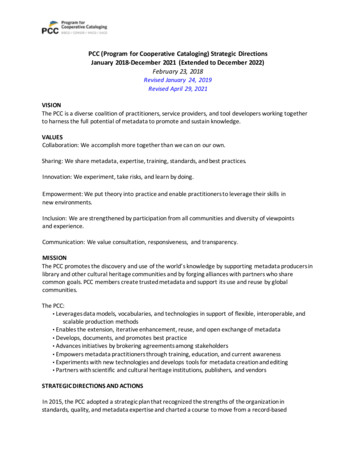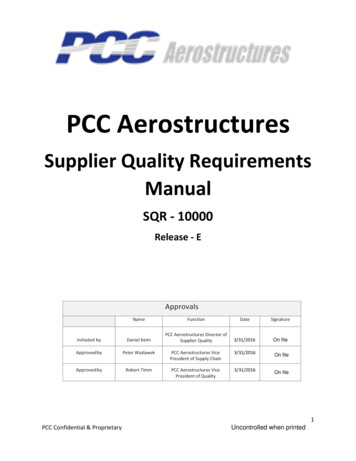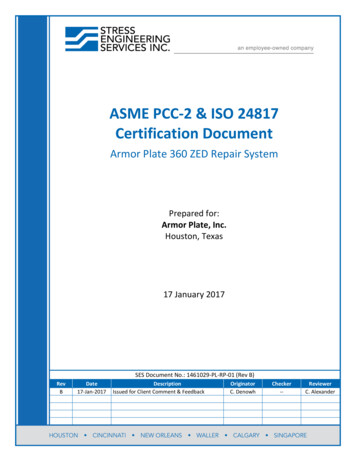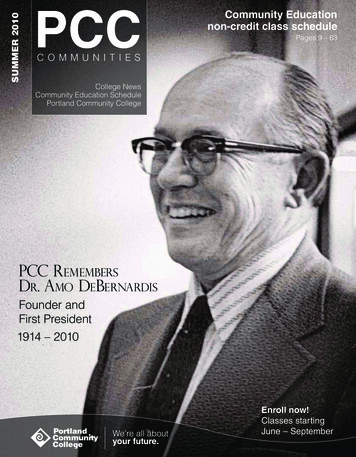
Transcription
PCC (Program for Cooperative Cataloging) Strategic DirectionsJanuary 2018-December 2021 (Extended to December 2022)February 23, 2018Revised January 24, 2019Revised April 29, 2021VISIONThe PCC is a diverse coalition of practitioners, service providers, and tool developers working togetherto harness the full potential of metadata to promote and sustain knowledge.VALUESCollaboration: We accomplish more together than we can on our own.Sharing: We share metadata, expertise, training, standards, and best practices.Innovation: We experiment, take risks, and learn by doing.Empowerment: We put theory into practice and enable practitioners to leverage their skills innew environments.Inclusion: We are strengthened by participation from all communities and diversity of viewpointsand experience.Communication: We value consultation, responsiveness, and transparency.MISSIONThe PCC promotes the discovery and use of the world’s knowledge by supporting metadata producers inlibrary and other cultural heritage communities and by forging alliances with partners who sharecommon goals. PCC members create trusted metadata and support its use and reuse by globalcommunities.The PCC: Leverages data models, vocabularies, and technologies in support of flexible, interoperable, andscalable production methods Enables the extension, iterative enhancement, reuse, and open exchange of metadata Develops, documents, and promotes best practice Advances initiatives by brokering agreements among stakeholders Empowers metadata practitioners through training, education, and current awareness Experiments with new technologies and develops tools for metadata creation and editing Partners with scientific and cultural heritage institutions, publishers, and vendorsSTRATEGIC DIRECTIONS AND ACTIONSIn 2015, the PCC adopted a strategic plan that recognized the strengths of the organization instandards, quality, and metadata expertise and charted a course to move from a record-based
environment to one based on dynamic collections of metadata statements and identity management.Strategic directions focused primarily on extending the collective understanding of emergingtechnologies and connecting with other partners. Significant progress has been made in several areas,including work to accommodate URIs in our current MARC environment, awareness of requirements forviable linked data implementation and infrastructure models, and envisioning the role of the PCC in theemerging identity management environment. The PCC partnered with Linked Data for Production(LD4P) and the ISNI (International Standard Name Identifier) International Authority to experiment andpilot new approaches and also drew on the expertise of individuals outside the traditional PCCmembership to better understand and align with practices in other metadata communities.It is time to move beyond knowledge and skills related to linked data at a theoretical level and intoimplementation. Building on the PCC’s strong tradition of providing training for metadata creators,active experimentation and piloting of linked data practices will help inform policy decisions, training,and operationalizing such practices. As we move to a culture of greater data sharing, it is crucial toextend our community, both by engaging a more diverse range of members in the work of the PCC andby collaborating with vendors, open source communities, and others.Transitioning to a linked data environment provides new opportunities and highlights areas in which thePCC must evolve. It will involve changing practices, such as how we do name authority work or providesubject access, and reviewing legacy practices to determine what can be let go, to keep PCC worksustainable. To carry out our plans, we must ensure the effectiveness of the PCC as an organization:improving internal coordination, communication, and follow-through. In addition, the current nature ofthe PCC and its structure reflect its past rather than its future. That past is a stable, MARC-dominatedcooperative environment rather than the emerging post-MARC, broadly collaborative environment. Onekey issue for the PCC is its legal status as an organization. Another issue is what it means to be amember of the PCC in this new environment.The strategic directions and actions will be assessed and updated annually by the Policy Committee, ormore frequently as circumstances require. In particular, the forthcoming changes to RDA will providethe impetus to reassess PCC practices for application of this standard.The PCC Policy Committee voted in October 2020 to extend these strategic directions by another yearfrom December 2021 to December 2022. Due to the COVID-19 pandemic appropriate planning for anentirely new set of strategic directions was not feasible in an all virtual environment. The PolicyCommittee did however decide to add a new SD7: Incorporate Diversity, Equity, and Inclusion (DEI)principles to every aspect of PCC operations at that point.PCC members may consult the working document PCC Strategic Directions Progress 2020- for updates.Please note that this document is updated continuously and was originally designed for internal PolicyCommittee use.SD1: Broaden our scope to be more diverse, inclusive, and collaborative with metadata creators inresearch and cultural heritage communities and with other agencies and project partnersThe PCC is acknowledged as a leader in standards and training but it must become a thought leader aswell. As the community continues to evolve by incorporating additional standards, schemas, and toolsinto its workflows, as well as new methods and models of collaborating, it is critical both to ensure that2
all those in our community are brought along and that we continue to reach out to other communitiesto learn from their ideas and expertise. During the period 2015-2017, the PCC embraced the transitionto linked data. It is time now to consolidate lessons learned and create a cultural infrastructure thatsupports inclusion, collaboration, and learning.Actions1.1 Using our Values Statement as a starting point, establish a Task Group charged to assess PCC’sstrengths and weaknesses as an organization. Consider ways to increase membership participation andbroaden PCC’s skill base and community of practice. Specifically:1. Identify PCC initiatives and areas of activity that resonate with other communities andincorporate outreach into those efforts2. Explore alternative models for membership (e.g. moving beyond production targets, includingindividual participation)3. Expand liaisons to cover a wider range of partner communities4. Increase the inclusiveness and diversity of the membership5. Work to expand international participationWho: Volunteers from Policy Committee & PCC membership on a Task GroupTimeline: Year 11.2 Create more timely, collaborative, and wide reaching mechanisms for learning and innovation thatare easily shared and sustained. Seek out and implement specific avenues such as webinars, conferencespeakers, hackathons etc. for sharing information with other communities (e.g., Wikidata, ORCID) toincrease our visibility and foster information exchange.Who: Steering, Policy Committee, consult with the Linked Data AdvisoryCommitteeTimeline: Year 2-5SD2: Maximize PCC’s operational effectivenessThe PCC today operates in a complex, interconnected, and rapidly evolving environment. As acooperative it must be responsive to the interests and concerns of stakeholders and ensure that it iscoherent in its overall direction and decisive in its actions. It is also critical to PCC’s success as avolunteer organization that it maximizes the return on the effort invested by its members.Actions2.1 Institute a transparent, consultative, and timely decision-making process. Develop a formalconsultation and review process that ensures accountability, adequate feedback along the way, andtimely response to or implementation of recommendations.Who: Steering, Policy CommitteeTimeline: In progress2.2 Adopt agile techniques that encourage experimentation and iterativedevelopment.1. Explore models for agile project management.Who: Steering, Standing Committee on Training, or possibly specially charged groupTimeline: Year 1-52. Identify further opportunities for pilot projects.3
Who: Steering, Standing Committees, Linked Data Advisory CommitteeTimeline: Year 1-53. Consider instituting a beta phase for new projects, tools, and practices that allowsexperimentation and feedback.Who: Policy CommitteeTimeline: Year 1-52.3 Improve coordination of related efforts among PCC groups.1. Monthly calls (already happening, but consider how to make them work best in terms ofmembership, participation, documentation, etc.).2. Make better use of liaisons (more consistent reporting out, etc.).3. Make better use of collaboration tools.Who: Policy CommitteeTimeline: Year 1-52.4 Streamline documentation and improve its searchability and visibility for ease of maintenanceand use. Explore creation of a general PCC working/collaborative space.1. Charge a task group to identify needs and audiences served by PCC documentation and makerecommendations for appropriate platforms and best practices.Who: Task Group reporting to Policy Committee, with Standing Committee on Training &Standing Committee on StandardsTimeline: Year 2-52.5 Appoint a volunteer PCC Communications Group to explore communication practices and toolsto reach out and engage with the broader community. Consider blogs, committee updates to the PCCdiscussion list, web forums, etc. Communication channels will be developed to and from the PCCcommunity, between task groups and committees, and outward to other communities.Who: SteeringTimeline: Year 1SD3: Apply understanding of linked dataIn order to define best practices and realize the benefits of linked data, the PCC will provideopportunities for practical, hands-on experimentation in both linked data and hybrid MARC/linked dataenvironments. Sandboxes in which PCC members can create RDF data according to PCC guidelines willhelp inform decisions about policy and training. A shared, interactive space for experimenting,learning, and collaborating could enable PCC members to learn about linked data initiatives and toolsand foster community exchange of ideas. In addition, the PCC will facilitate the incorporation of linkeddata and associated practices into current production environments (see related work in SD5). The PCCwill continue its strong tradition of providing training to assist the community’s transition to a linkeddata environment and to support different paces of adoption, as there will be a period of overlap inPCC members’ production of MARC data and native linked data.Actions3.1 Partner with LD4P to develop a sandbox for experimentation in the creation of RDF data accordingto PCC guidelines.1. Explore ways to act on mappings developed by the PCC BIBFRAME Task Group, to reinterpret4
the BIBCO Standard Record and CONSER Standard Record in a linked data context, and toinvestigate the concept of PCC quality in a recordless environment.2. Investigate policy and training needs in both the transition to linked data and in a mixedMARC/linked data environment.Who: Policy Committee work with PCC Linked Data for Production cohort groupTimeline: Year 1-33.2 Explore the feasibility of creating a shared interactive space for experimenting withand implementing linked data beyond BIBFRAME and the LD4P sandbox.1. This shared space could include documentation of application profiles, lists of tools, end-userenvironments, a directory of initiatives, and/or ontology vetting.2. Collaboration with vendors will help ensure that tools meet the community’s needs anddemonstrate to vendors the demand for these tools.3. This space should help articulate the value of linked data on the supply side and in the discoveryenvironment.4. This will be a visible, interactive space for engagement and will serve as a connector for variousPCC initiatives and resources related to linked data.Who: Joint task group involving Standing Committee on Applications, Standing Committee onTraining, and Linked Data Advisory CommitteeTimeline: Year 3-53.3 Extend previous work to develop a curriculum that will advance the community’s understanding oflinked data and develop training for incorporating linked data and associated practices into currentproduction environments.Who: Standing Committee on Training, in collaboration with Standing Committee on Standardsand Linked Data Advisory CommitteeTimeline: Year 2-53.4 Review current practices in cataloging and authority work to assess their impact andcontinuing value in a linked data environment and, where applicable, explore feasible alternatives.(See also specific directions set out in SD4 and SD5.)1. Develop linked data use cases for NACO data. Identify functional requirements and propose bestpractices that will support them.2. Identify high-value external data sources and propose strategies for leveraging them to augmentPCC metadata.Who: Policy Committee; SteeringTimeline: Year 2-5SD4: Accelerate the movement toward ubiquitous identifier creation and identity management at thenetwork levelWe aspire to attain an environment where identity management work activity is characterized by muchgreater proportions and numbers of entities receiving identifiers; many non-NACO institutionsparticipating; and strategic partnerships and collaboration existing among cultural heritageorganizations, rights management agencies, Wikidata, and others. We expect to find ways in a linkeddata environment where collaboration on identity management can interoperate across multiple datasources. Attainment of this vision will increase both human and machine usage of this data and its5
overall value.Actions4.1 Lower barriers and expand the community doing identity management work within the frameworkof the PCC with support and training. Further define what is meant by the “NACO Lite” concept andreview standards for minimal requirements.Who: PCC Task Group on Identity Management in NACO; Standing Committee on TrainingTimeline: Year 1-24.2 Develop a pilot using identifiers in place of or in addition to text strings.Who: PCC Task Group on Identity Management in NACO; Policy Committee;SteeringTimeline: Year 2-44.3 Collaborate with other identity management communities to facilitate and promote the use ofunique identifiers.1. Evaluate the results of the ISNI pilot and plan next steps for bringing the pilot into production.Who: PCC ISNI pilot libraries; Steering; Task Group?Timeline: Year 12. Identify common goals and interests, best practices, and technology to support reuse,aggregation, and sharing of data.Who: Standing Committee on Applications; Standing Committee on StandardsTimeline: Year 2-53. Investigate policy and governance issues related to participation in a program-like operation forISNI, VIVO, ORCID, Wikidata, and other non-NACO identifiers.Who: PCC Task Group on Identity Management in NACO; Policy Committee; SteeringTimeline: Year 2-5SD5: Expand use of linked data value vocabularies to augment, and where feasible to replace, existingmetadata practicesLinked data vocabularies such as OCLC’s FAST, NLM’s MeSH, Getty’s AAT, and LC’s facetedvocabularies are purpose-built for wide reuse and interoperability. The movement towards linked dataprovides an opportunity to review PCC practices to take full advantage of these vocabularies. Identitymanagement (covered in SD4) is a prime area of opportunity for a transition to use of linked data, butsimilarly compelling opportunities exist in other areas such as subject, geographical, genre/form, anddemographic data. The ALA Subject Analysis Committee’s report A Brave New (Faceted) World offers auseful starting point for many aspects of this effort.Actions5.1 Expand adoption of FAST.1. Produce and document implementation strategies for libraries wishing to adopt FAST2. Partner with OCLC on a roadmap for enhanced tools and services, and a governance model forongoing development of FAST.Who: Cohort of FAST adopters in collaboration with SteeringTimeline: Year 2-56
5.2 Institute a process for endorsing vocabularies for PCC use, developing best practicesand documentation, and identifying any further steps required.Who: Steering, Standing Committee on Standards, Standing Committee on Training, Linked DataAdvisory Committee, specialist communities (ACRL Rare Books and Manuscripts Section, MusicLibrary Association, etc.)Timeline: Year 2-55.3 Review legacy practices to identify areas where adoption of linked data would offer advantagesand propose transition strategies.Who: Standing Committee on Standards, Standing Committee on Applications, collaborate withALA Subject Analysis Committee?Timeline: Year 2-55.4 Develop and implement strategies for targeted enhancement of legacy metadata with linkeddata vocabularies.Who: Standing Committee on Applications, specialist communities, OCLC?Timeline: Year 2-55.5 Provide input to metadata editor development at LC, LD4P, and other venues to maximize the use oflinked data vocabularies.Who: Library of Congress, LD4P partnersTimeline: Year 2-55.6 Promote routine use of URIs in PCC cataloging in place of or in addition to text strings.Who: PCC Task Group on Identity Management in NACOTimeline: Year 2-5SD6: Bolster resources for PCC to support the PCC’s strategic directions and the overall sustainabilityof the ProgramThe current nature of the PCC as an organization and its structure reflect its past rather than its future.In the next few years, the PCC needs to act on several fronts identified in the previous and currentstrategic plans. Key issues for the PCC include its legal status as an organization, its governance, and itsability to raise and apply resources.Actions6.1 Create a task force to investigate how other organizations meet these challenges and toevaluate pros and cons of specific models for the PCC becoming a legally recognized entity andmake recommendations.Who: Steering and Policy Committee will create the task forceTimeline: Year 16.2 Assess the impact of the strategic directions on the PCC’s membership, contribution,and governance structures.1. Define what it means to be a PCC participant in a linked data environment and to create qualitydata.2. Review legacy practices to determine what can be let go, to keep PCC work sustainable.7
Who: Steering, Policy CommitteeTimeline: Year 2-56.3 Seek grant funding and consider means for acquiring sponsorships and developing donor supportfor some aspects of the PCC’s programs and services.Who: Steering, Policy CommitteeTimeline: Year 3-5SD7: Incorporate Diversity, Equity, and Inclusion (DEI) principles to every aspect of PCC operationsPCC is committed to incorporating DEI principles (including accessibility) in its work. We recognize thatworking with a diverse pool of individuals broadens our perspective and enriches our work.Actions7.1 Charge an Advisory Committee for making DEI and metadata ethics an integral part of PCC work.Who: Policy CommitteeTimeline: Year 47.2 Increase awareness of DEI issues as they relate to cataloging and to the PCC.Who: PCCTimeline: Ongoing7.3 Formulate a statement of DEI principles for libraries to use regarding their metadata.Who: PCC Advisory Committee on Diversity, Equity, and Inclusion with Policy CommitteeTimeline: Year 47.4 Increase diversity of membership on PCC committees and task forces.Who: All PCC committees (including Policy Committee and future nominatingCommittees), task forces, and individual programs (when they create task forces,committees, etc.)Timeline: Ongoing1. Survey PCC committees and task forces to determine current level of diversity.Who: Policy Committee assisted by all PCC committees, task forces, and individual programsTimeline: Year 47.5 Explore partnerships with other organizations and institutions to participate in and promote DEIinitiatives.1. Compile list of organizations for potential partnerships.Who: PCC Advisory Committee on Diversity, Equity, and Inclusion with PCC Policy CommitteeTimeline: Year 4 (reviewed annually)2. Reach out to other organizations (including but not limited to CFLA Indigenous MattersCommittee, OCLC, LD4 Ethics in Linked Data Affinity Group)8
Who: Policy CommitteeTimeline: Year 4-59
PCC (Program for Cooperative Cataloging) Strategic Directions . January 2018December 2021 (Extended to December 202- 2) February 23, 2018 . Revised January 24, 2019 . Revised April 29, 2021 . VISION . The PCC is a diverse coalition of practitioners, service providers, and tool developers working together










